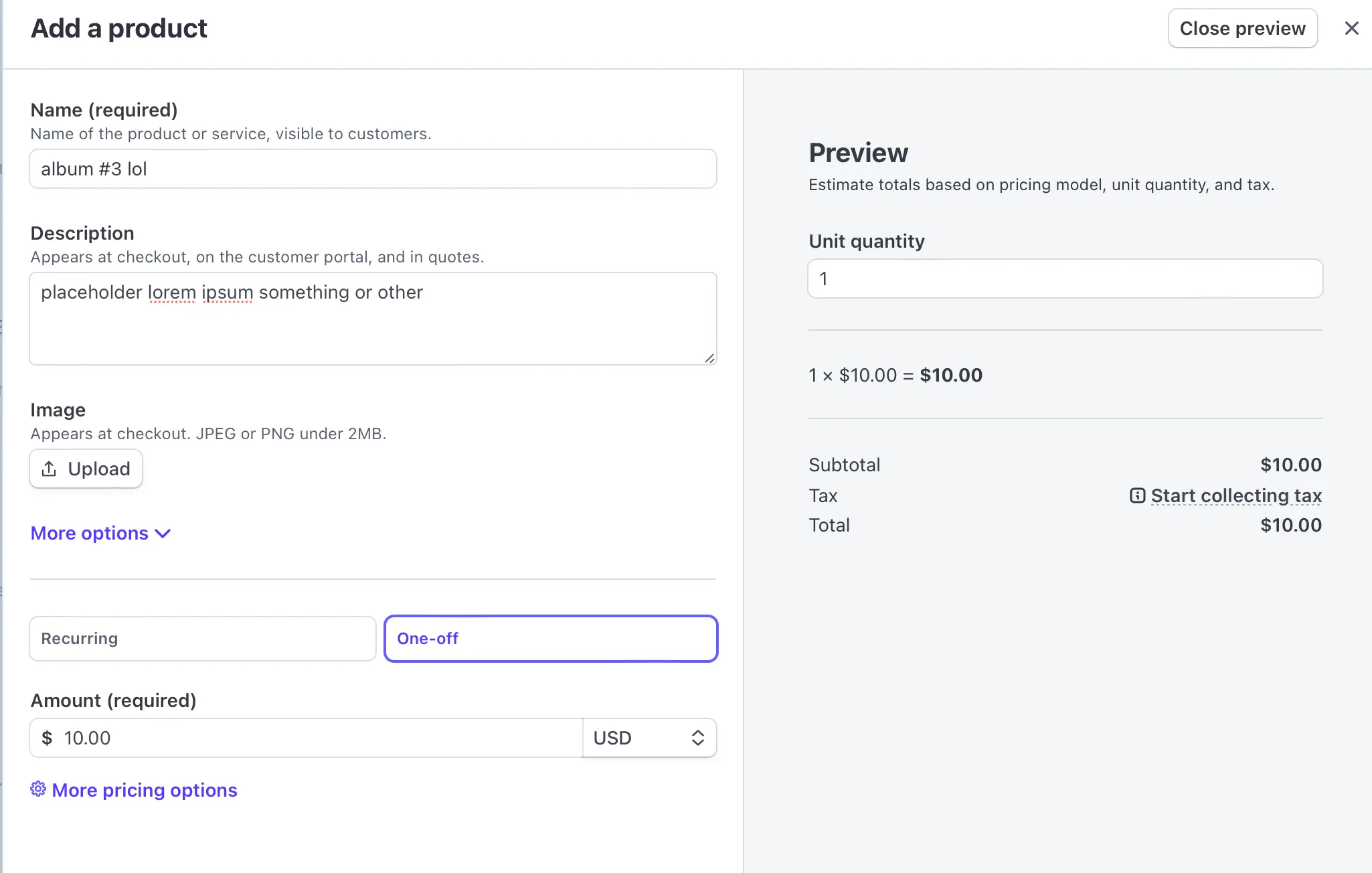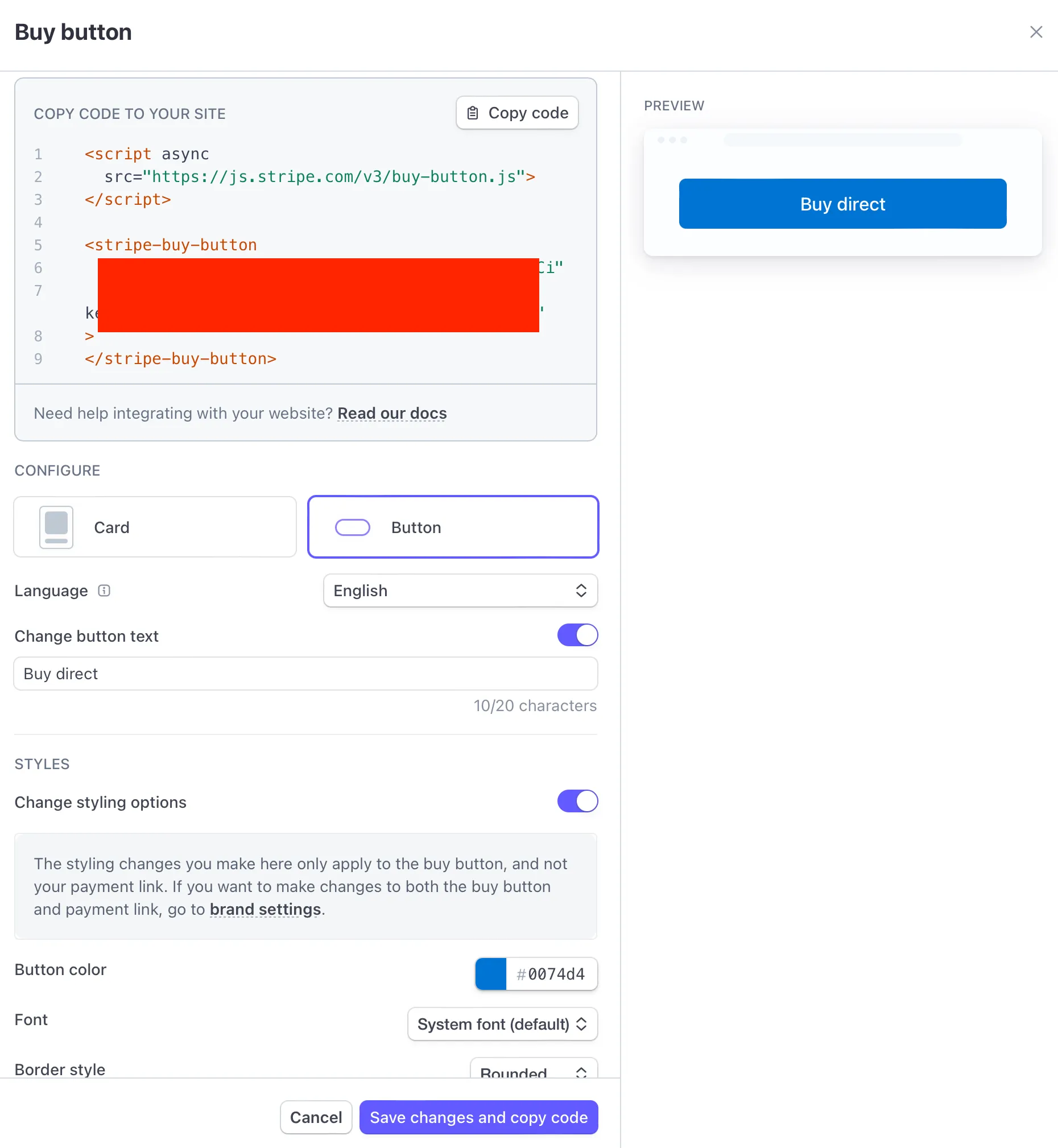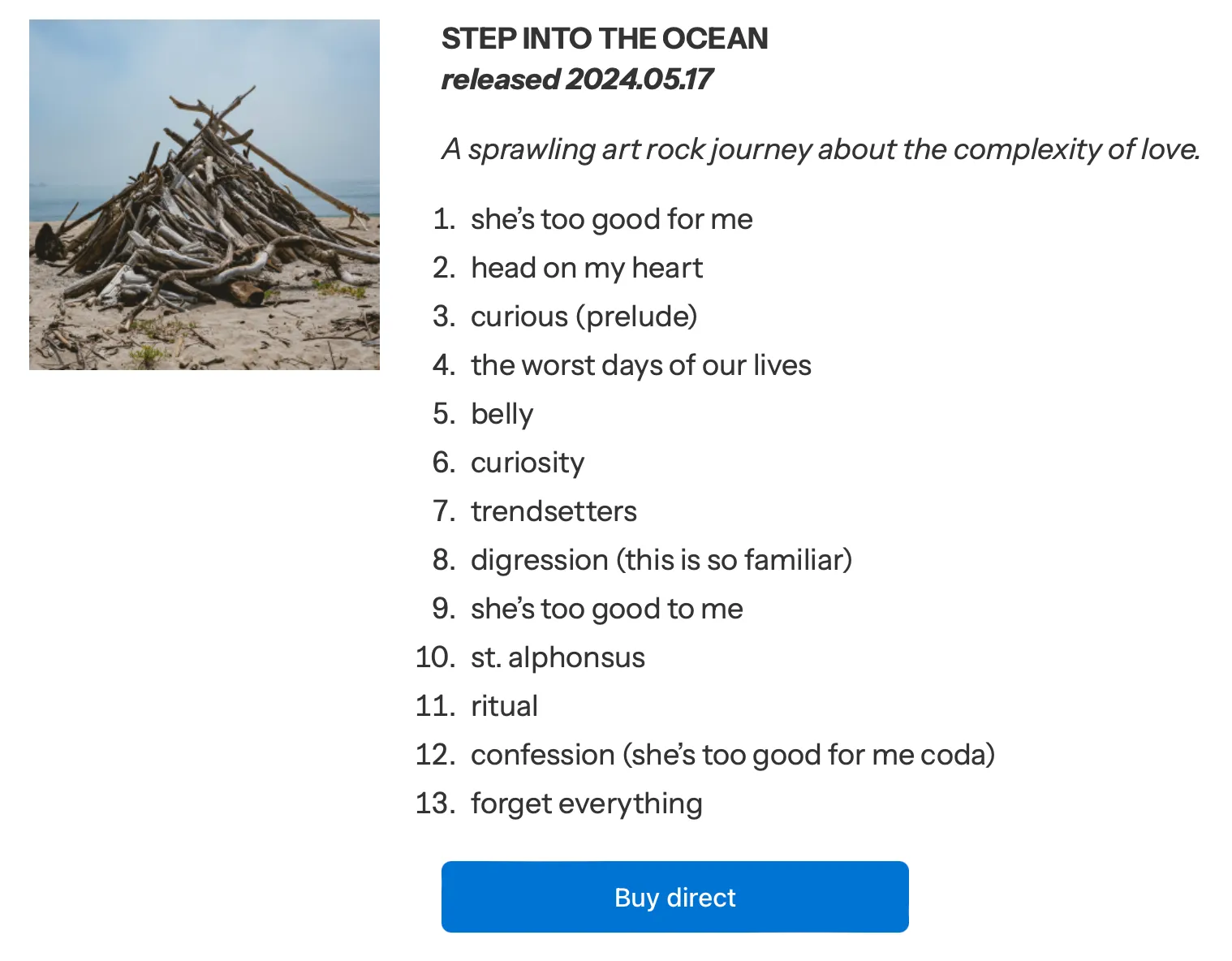Internet DIY: My own music selling mechanism
Three weeks ago I laid out some background on why I care about staying independent as an online-first musician, and the principles I’ll try to stick to in doing so. Now I’ll go a bit deeper on one of my DIY explorations: selling my music directly to people who want to buy it.
I have set this up on kidlightbulbs.com, such that viewers can buy any of my music from me directly – not on Bandcamp or the iTunes Store or at a record shop, but via a payment link that I control and from which I receive all the buyer’s money (less processing fees, which are basically unavoidable if you want to accept credit cards). I don’t need to hand 15% of it to a third party. At my tiny scale, this is insignificant, but at a certain scale it means a lot of money the artist does not get for their work.
Background
Back in my late teens, I was in a weird instrumental prog rock band. We built a decent following in southern Connecticut as a niche act. We formed in 2004 - CD burning technology (and piracy generally) was already pretty widespread, but streaming hadn’t come around yet. We also had no idea what other bands were doing to make, promote, distribute their music, so we just tried a bunch of stuff — like burning our poor-quality demos to a CD, slapping together some ridiculous artwork in my mom’s copy of Microsoft Publisher, printing them on my inkjet printer at home, assembling a few CD packages, and selling them for $5 at shows. And we sold some! Between that and simply playing shows and talking with folks before and after said shows, we build this small following that allowed us to open for some national touring (albeit obscure) acts like Fish (from the band Marillion), Starship (fka Jefferson Starship), and The Machine (a noteworthy Pink Floyd tribute band). We also got some press and were offered a management contract at one point– not because we had our stuff played on radio or had a certain number of followers on MySpace and Facebook at the time, but because people were talking about our stuff IRL.
IRL stuff obviously happens still, but overwhelming what matters is online social proof. Yes, you can get press, radio play, and so on, but most artists gain a meaningful following through painstaking, neverending content marketing to push Spotify plays, getting lucky with a viral TikTok video, or being born into money or a recording industry family. Even if you do, unless you are Taylor Swift (and basically only that), you don’t make a sustainable living doing so. We weren’t making meaningful cash as a local New Haven band, but we did make a tiny bit of money on these burned CD sales, t-shirts, and so on – and if the industry hadn’t changed, and we kept at it, it’s possible we could have. Now it simply seems impossible… unless there’s another way.
I like to tinker with websites, always have. I never formally learned how to code but would mess around with services like WordPress and Drupal just to see what I could do with them. Working with software engineers for the last 15 years, I’ve gradually picked up concepts and know-how that has gotten me slightly better at this (or at least awareness of what is possible on the Internet with very little effort).
In the last year, a lot of things happened that ultimately led to me caring about the value of my music:
- I lost a job during a brutal tech job market, which had me exploring myriad other ways of making money while I looked for my next job
- I met a bunch of great musicians (many of which I’d call friends now!) all challenging & lifting each other up to elevate our art and the attention it’s getting
- Bandcamp, arguably the last holdout music platform working in support of independent musicians, got sold again, and then gutted half its staff
- Spotify cut its royalty payouts for all artists generating less than 1,000 streams per song per year, funneling those funds instead to (mostly) major-label artists
On that last one: from a business strategy standpoint, I understand why Spotify changed its royalty mechanics. I’d make pennies for the few hundred streams some of my songs are getting; it was never a viable source of income other than for the extremely successful 0.001% of musicians. But the gesture makes clear the painful reality of streaming: It is for consumers first, suppliers (artists) second, and unless you are in the extreme upper minority of the supplier base, you basically cannot make money in this model. Therefore, I no longer think of Spotify as a source of royalty revenue, but rather a sometimes-predictable marketing channel for my music and the Kid Lightbulbs brand.
Somewhere in the middle of this (in early April ’24), Pharrell decided to release his new album Virginia: Black Yacht Rock Vol. 1 on a random website with no press or gimmicks – you can go there right now and stream or download the whole album for free, with an option to provide your email address.
This is ballsy, but Pharrell can afford to do it. It’s also not the first instance of this – Radiohead did this in 2007 with In Rainbows (introducing the “name your price” model for music sales), and plenty of artists have gradually offered other ways of supporting their craft since then thanks to platforms like Bandcamp and Patreon.

Each of those platforms takes a fee. Again, this makes sense: Bandcamp offers infrastructure that many musicians can’t fathom managing themselves. But in 2024, it’s increasingly easy to set up much of this infrastructure on one’s own, using platforms that everyone (including listeners) already uses. So I did. Turns out it’s actually quite possible to sell your (digital) music without any of those big platforms claiming to be the best or only way to do so.
And if you have even a small base of fans willing to invest, they’ll buy from you – I’ve made nearly $500 on pre-orders alone for my second album (STEP INTO THE OCEAN), about 10% of which came through direct sales on my website. The rest came through Bandcamp, which is fine for now and I promoted heavily, but the fact that I generated more than $0 in money from a website I fully control is interesting.
A quick warning
Before I actually get into any of this, I want to lay out a few disclaimers because there is a fair amount of risk involved with the approach I took. I don’t think I recommend the specific approach I took to anyone unwilling to experiment or understanding the flaws, which I will document throughout this writeup. In a lot of ways, the approach I took does resemble the rough process of burning a CD, printing an inkjet album cover, and slapping it together oneself - but early fans are willing to work with that. I also personally believe that a good fan puts value in the art they’re buying, far more than the distribution method. A set of MP3s is a set of MP3s, no matter how they arrive in your inbox.
How I did it
Here is a list of every tool and service I used to set this all up:
- Stripe, the online payments platform - 2.9% + 30 cents per transaction
- Dropbox as the file storage and distribution mechanism - $9/month (or free if you don’t need a lot of storage space). You can also use Mega.nz, Google Drive, iCloud Drive, or basically any cloud storage provider to do this.
- Song.link to dynamically offer links to stream my music anywhere the listener wants - free
- Buttondown, an “headless” email newsletter service - free for up to 100 subscribers, otherwise $9/mo starting price
I could also count Blot, the service I’m using to power this site, but it’s technically not necessary unless you are also writing a blog online. You can spin up a site on a number of services for free or cheaply, buy a domain for $10, and point the domain to that site. I recommend Carrd for this, or a free link-in-bio service like Buffer’s Start Page1.
Chances are, if you use Patreon, Ko-fi or even Bandcamp, you’re familiar with Stripe (or PayPal in the case of Bandcamp album purchases). These platforms also use Stripe to power their payment processing. When someone buys your music or merch on Bandcamp, you lose both Bandcamp’s cut (10-15%) and a payment processing fee to Stripe or PayPal.
Here’s a fun thing about Stripe: They actually have a number of no-code, incredibly consumer friendly services that allow you to take payments online in a great, trustworthy user experience, both for you and the patron.
The piece that’s missing from Stripe is distribution. Distribution is hard; I would absolutely not want to take on distribution of physical merch in some DIY fashion. (I know I could, but I also don’t want stacks of Kid Lightbulbs t-shirts sitting in my basement or the burden of having to package and ship them out.)
Digital distribution, while hard, is a lot easier in 2024. Secure file hosting solutions abound, and some have great solutions for securely sharing large sets of files, like an album of songs in multiple formats with artwork and liner notes. I chose Dropbox because it (mostly) aligns with my values, is super reliable, and even has file access monitoring and password protection on files if I wanted to really lock down this process.
How it works in practice
I need a way to easily share the finished album with people who bought it from me – so, here’s the process as it stands today:
- Someone goes to kidlightbulbs.com and wants to buy an album of mine
- They click on the “Buy direct link” and are taken to a checkout page hosted by Stripe
- They pay however they like
- They get an email confirmation, and so do I
- As soon as I get that confirmation of payment, I simply send the buyer a templated email with a Dropbox link to download the album
Simple as that. It’s like I burned you a CD and emailed it to you.
What if someone emails you in the middle of the night? Currently, they’ll need to wait until I see their email the following morning. This isn’t ideal, but I am pretty sure I can embed the Dropbox link into the payment confirmation email itself, so the buyer can download it immediately after paying.
Does the email look sketchy/unprofessional? I don’t personally think so, because I wrote a concise, grammatically correct and somewhat personalized emial that thanks the user again for buying my music. I’ve had a few people buy direct from me, and they’ve said it’s been great!
Setup process
1) Compress your album/song/whatever, along with its cover art, into a .zip file. On macOS, you can easily do this by selecting all the files, control-clicking, and choosing “Compress.” You can also do this on Windows.
I’d recommend including your music in multiple formats — at least WAV and MP3 — so the buyer has the best quality audio you can send them.
2) Build yourself a simple artist site. I recommend Carrd, Blot, Wordpress or Ghost for this.
This is key. The social networks, Linktrees, and a lot of “artist profiles” block stuff like taking your own payments, or heavily limit what you can do, and many of them have policies allowing them to take down your site or profile without warning, are likely to raise prices due to their incentives to grow or profit massively, or just go away as the tech landscape continues to change. The services I recommend are simple, reliable, powerful and don’t (seem to) have those problems.
Even if you want to stop here because your music is just fine on Bandcamp and Spotify and whatnot, you should have a website that you control. If you are an independent artist and are struggling to figure this out, email me and I will help you.
3) Create a Stripe account & verify yourself. Once you do, you’ll have access to a big dashboard. It looks intimidating and like it was built for software developers — which it originally was! — but there are some quite easy-to-use and (dare I say) fun features in here we’ll dive into.
4) Create your “products” in Stripe (ie. any album, single, or other thing you’d want to sell) and set their prices.
- Click on “Product catalog” on the left side.
- Click on “Add product”.
- Fill out some basic information on the album, single, etc. you’re looking to sell. You can set a fixed price, or click on “More pricing options” to enable name-your-own pricing if you like!

5) For each product, create something called a Payment Link. This is basically the thing you embed on your website to allow visitors to buy from you. You can create one for any price point that you want to sell your products for.
- Find and click on the “Create payment link” button.
- Click the “Buy button” option. (There is also an option to get a simple link, but it’s more work to get it looking nice.)
- Customize to your liking. There are two different designs (I prefer the simple button), and you can customize the text and color of it.
- Click “Save changes and copy code.” This gives you an embed code to place on your site.

6) Put the Payment Link embed code onto your website. Knowing where to paste it depends on your site builder you chose and how exactly you want it to look. Here are a few tips:
- If you went with Carrd, they have an “Embed” block, which allows you to put code into a special block that looks nice and contained around the other elements on your site.
- On Ghost or **Wordpress, you can include an “Embed” block on a specific page of your site in that page’s editor.
- Blot allows you to write whole pages of your site in Markdown, and you can paste the embed code directly into a page’s markdown file. (This is what I did for kidlightbulbs.com.)
In the end, it could look something like this:

And now you can sell your music directly to fans, on a site you fully control without having to pay out a platform fee.
Other future enhancements or fun ideas to try
Add purchasers to your email list automatically
Got an email newsletter? Your email newsletter service probably has an integration with a service called Zapier, which is a cool automation service with a free option. You can build an automation that grabs the email from someone who’s purchased, and add them to your mailing list. (Make sure either (1) you ask the user in the Stripe settings if they want to opt into emails from you, or (2) your newsletter service sends that person an opt-in confirmation, otherwise you just subscribed someone to an email list without their consent 😬)
Broadcast to your social channels every time (or every day) someone buys
You can set this up with the aforementioned Zapier workflow that triggers upon a purchase, and have it also publish a social post through a service like Buffer.
Discounts / coupons
Stripe makes it somewhat easy to spin up discounted pricing if you want to run a sale for a limited time. You can do this by going to your product listing(s) in Stripe, hitting Edit Product, then adding a new price you can set as the Default.
You can also set up Coupons if you’d rather run a sale that way, or offer something exclusively to your fans/patrons at a discount.
I’m not sure if this is worth the effort it took to figure it out. But it’s very nice to know that there is technology to DIY my online selling of music.
Disclaimer: I am employed by Buffer as of this writing.↩︎